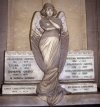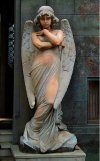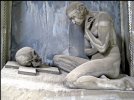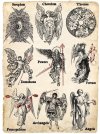-
Sign up or login, and you'll have full access to opportunities of forum.
You are using an out of date browser. It may not display this or other websites correctly.
You should upgrade or use an alternative browser.
You should upgrade or use an alternative browser.
Women angels are women right?
- Thread starter g2320
- Start date

g2320
Condemned
Depends on the fantasy of course. Angels in Asian depictions are mostly female. One of my favorite Chinese anime for instance had both male and female angels, with the female ones completely eradicated their male counterparts.I always thought angels were supposed to be sexless - beautiful but androgynous. After all, if you're immortal, reproduction is likely unnecessary and undesirable.
Frank Petrexa
Tribune
In genesis, I think, there is a short passage about immortal beings who find the "daughters of men" "comely" and mate with them, passing on their immortality. This is like Greek mythology (and probably copied from it during the long dominance of the heirs of Alexander the Great), where numerous gods (including Zeus, which pisses off Hera) rape various maidens and generate offspring. I assume these beings are "angels". God puts a stop to it.I always thought angels were supposed to be sexless - beautiful but androgynous. After all, if you're immortal, reproduction is likely unnecessary and undesirable.
No idea, but in this mythology, God has a pretty good idea. Imagine immortals mating with human women and producing immortal children, who then go on to produce more immortal children. No death to balance the population. IT'S BAD ENOUGH ALREADY WITH ALL THE MORTALS REPRODUCING LIKE MAD. I CAN'T KEEP UP!In genesis, I think, there is a short passage about immortal beings who find the "daughters of men" "comely" and mate with them, passing on their immortality. This is like Greek mythology (and probably copied from it during the long dominance of the heirs of Alexander the Great), where numerous gods (including Zeus, which pisses off Hera) rape various maidens and generate offspring. I assume these beings are "angels". God puts a stop to it.

That only makes a difference if you think that there is a size limit or housing shortage in Hell.Reminds me of the show Supernatural a bit. If Demons come from tortured humans and angels were made in only one batch initially, then obviously eventually they are going to be out numbered to a ridiculous degree. In that case, I'd argue being able to procreate is a good thing

Frank Petrexa
Tribune
This is an open and somewhat technical question.That only makes a difference if you think that there is a size limit or housing shortage in Hell.
https://www.albany.edu/faculty/miesing/teaching/assess/hell.html
Angels enjoy sexual relations in Milton's Paradise Lost, though in a mysterious way, similar to the way Adam and Eve enjoy sex before the Fall - but he's equally vague about that. On the other hand, Satan has sex in the familiar, 'impure', way with a female 'reflection' of himself, makes himself pregnant, and births wee devils. Aquinas had given a rather similar account: angels in Heaven aren't male or female, but they unite with each other in a mystical way of pure love (when they appear in human form, they can be male or female, but don't engage in sex between themselves or with humans).
The 'sons of God' that get wed to the 'daughters of men' in Genesis 6 are pretty surely ill-disguised traces of an ancient polytheistic tradition (as are several other hints in the Hebrew Bible) where God is only the chief of a whole community of lesser divine beings - later these get demoted to something quite different in nature from the One God, but still with various different characters - lumping them all together as 'angels' (a Greek term for 'messenger', Hebrew mal'k) is a late development in Hellenistic Judaism and early Christianity.
The union of these heavenly males and earthly females put God in a quandary, as their offspring would be immortal. He prevented the potential population problem by capping all human life at 120 years. Nevertheless, the infants turned out to be giants (Nephilim), who were around on the Earth at least until the Flood.
In genesis, I think, there is a short passage about immortal beings who find the "daughters of men" "comely" and mate with them, passing on their immortality. This is like Greek mythology (and probably copied from it during the long dominance of the heirs of Alexander the Great), where numerous gods (including Zeus, which pisses off Hera) rape various maidens and generate offspring. I assume these beings are "angels". God puts a stop to it.
The 'sons of God' that get wed to the 'daughters of men' in Genesis 6 are pretty surely ill-disguised traces of an ancient polytheistic tradition (as are several other hints in the Hebrew Bible) where God is only the chief of a whole community of lesser divine beings - later these get demoted to something quite different in nature from the One God, but still with various different characters - lumping them all together as 'angels' (a Greek term for 'messenger', Hebrew mal'k) is a late development in Hellenistic Judaism and early Christianity.
The union of these heavenly males and earthly females put God in a quandary, as their offspring would be immortal. He prevented the potential population problem by capping all human life at 120 years. Nevertheless, the infants turned out to be giants (Nephilim), who were around on the Earth at least until the Flood.
Loxuru
Graf von Kreuzigung
Here is an angel that is no doubt depicted as female, a real seduceress, actually. Giulio Monteverde's Angel of the Resurrection, in Genova. At its inauguration in 1882, the sculpture caused a scandal, for its female sensuality. Mind that she has a belly button, making her in fact 'mortal'.

And what you see is what you get :


And what you see is what you get :

captivecuties
Senator
And Hell is always open,even on Christmas.That only makes a difference if you think that there is a size limit or housing shortage in Hell.
Loxuru
Graf von Kreuzigung
Frank Petrexa
Tribune
If I recall in Catholic tradition there are twelve levels of angels, archangel being on only the second level (principalities, powers, cherubim, seraphim are others). Since the battle in heaven that the rebel Satan led that resulted in his relegation to the kingdom of hell is not in the Canon as far as I know, I have never been sure where it came from. Enoch? From the endings they clearly come from some Hebrew source.Angels enjoy sexual relations in Milton's Paradise Lost, though in a mysterious way, similar to the way Adam and Eve enjoy sex before the Fall - but he's equally vague about that. On the other hand, Satan has sex in the familiar, 'impure', way with a female 'reflection' of himself, makes himself pregnant, and births wee devils. Aquinas had given a rather similar account: angels in Heaven aren't male or female, but they unite with each other in a mystical way of pure love (when they appear in human form, they can be male or female, but don't engage in sex between themselves or with humans).
The 'sons of God' that get wed to the 'daughters of men' in Genesis 6 are pretty surely ill-disguised traces of an ancient polytheistic tradition (as are several other hints in the Hebrew Bible) where God is only the chief of a whole community of lesser divine beings - later these get demoted to something quite different in nature from the One God, but still with various different characters - lumping them all together as 'angels' (a Greek term for 'messenger', Hebrew mal'k) is a late development in Hellenistic Judaism and early Christianity.
The union of these heavenly males and earthly females put God in a quandary, as their offspring would be immortal. He prevented the potential population problem by capping all human life at 120 years. Nevertheless, the infants turned out to be giants (Nephilim), who were around on the Earth at least until the Flood.
One wonders how much Aquianas knew about sex, and how he found out. (Maybe according to that line from the Peter Sellers movie "Being There": "I like to watch.")
Last edited:
9 choirs, in 3 x 3 ranks, descending: Seraphim, Cherubim and Thrones; Dominions, Virtues and Powers; Principalities, Archangels and Angels - only the last two have dealings with us fallen humans. There are various hints of these different entities in the Hebrew Bible, and Paul refers to some of them in a couple of epistles. But it was Pseudo-Dionysius, c500, who organised them in The Celestial Hierarchy. Although that's been taken as the standard version in the Catholic and Orthodox churches ever since, there don't seem to have been much in the way official statements about it by Popes or Councils.If I recall in Catholic tradition there are twelve levels of angels, archangel being on only the second level (principalities, powers, cherubim, seraphim are others). Since the battle in heaven that the rebel Satan led that resulted in his relegation to the kingdom of hell is not in the Canon as far as I know, I have never been sure where it came from. Enoch? From the endings they clearly come from some Hebrew source.
One wonders how much Aquianas knew about sex, and how he found out. (Maybe according to that line from the Peter Sellers movie "Being There": "I like to watch.")
The idea of the rebellion of Satan grew through the time the various books of the Bible were written - in the Hebrew Bible he's a persistent trouble-maker, at first a member of the (quasi-polytheistic) 'court' of God, but by the latest writings and the NT age he was at constant war with God - most dramatically in the Apocalypse. But the story of the 'rebellion' as told by Milton does, like you say, go back mainly to the Book of Enoch, [probably from the 1st century BC), in a passage which elaborates on the bit about the 'sons of God and the daughters of men' in Genesis 6.
Loxuru
Graf von Kreuzigung
In the beginning of the 20th century, God was no longer all mighty. Society had changed.
With the decline of religion, angels also lost their status and magnificence.
This angel, from around 1910 has lost her wings and is stark naked. Only the headband, for the communication with God, is left. Instead of bringing the victory of faith over death,, death has forced the angel to a confrontation, the latter sitting between her and the cross. It looks like that death is now dictating the terms, and the angel, concerned with protecting her modesty, can only obey!
The angel is, as you can see, clearly female too!

With the decline of religion, angels also lost their status and magnificence.
This angel, from around 1910 has lost her wings and is stark naked. Only the headband, for the communication with God, is left. Instead of bringing the victory of faith over death,, death has forced the angel to a confrontation, the latter sitting between her and the cross. It looks like that death is now dictating the terms, and the angel, concerned with protecting her modesty, can only obey!
The angel is, as you can see, clearly female too!

Frank Petrexa
Tribune
There is Mark Twain's "Letters from the Earth", written by Satan when he was sent on a mission as a punishment (like J Edgar Hoover used to assign people who crossed him to the Billings, Montana, FBI office), but I didn't think it was authoritative. He was astounded. "They think we spend all our time worrying about them."9 choirs, in 3 x 3 ranks, descending: Seraphim, Cherubim and Thrones; Dominions, Virtues and Powers; Principalities, Archangels and Angels - only the last two have dealings with us fallen humans. There are various hints of these different entities in the Hebrew Bible, and Paul refers to some of them in a couple of epistles. But it was Pseudo-Dionysius, c500, who organised them in The Celestial Hierarchy. Although that's been taken as the standard version in the Catholic and Orthodox churches ever since, there don't seem to have been much in the way official statements about it by Popes or Councils.
The idea of the rebellion of Satan grew through the time the various books of the Bible were written - in the Hebrew Bible he's a persistent trouble-maker, at first a member of the (quasi-polytheistic) 'court' of God, but by the latest writings and the NT age he was at constant war with God - most dramatically in the Apocalypse. But the story of the 'rebellion' as told by Milton does, like you say, go back mainly to the Book of Enoch, [probably from the 1st century BC), in a passage which elaborates on the bit about the 'sons of God and the daughters of men' in Genesis 6.
Naraku
Draconarius
Isaiah 14:129 choirs, in 3 x 3 ranks, descending: Seraphim, Cherubim and Thrones; Dominions, Virtues and Powers; Principalities, Archangels and Angels - only the last two have dealings with us fallen humans. There are various hints of these different entities in the Hebrew Bible, and Paul refers to some of them in a couple of epistles. But it was Pseudo-Dionysius, c500, who organised them in The Celestial Hierarchy. Although that's been taken as the standard version in the Catholic and Orthodox churches ever since, there don't seem to have been much in the way official statements about it by Popes or Councils.
The idea of the rebellion of Satan grew through the time the various books of the Bible were written - in the Hebrew Bible he's a persistent trouble-maker, at first a member of the (quasi-polytheistic) 'court' of God, but by the latest writings and the NT age he was at constant war with God - most dramatically in the Apocalypse. But the story of the 'rebellion' as told by Milton does, like you say, go back mainly to the Book of Enoch, [probably from the 1st century BC), in a passage which elaborates on the bit about the 'sons of God and the daughters of men' in Genesis 6.
12How art thou fallen from heaven, O Lucifer, son of the morning! how art thou cut down to the ground, which didst weaken the nations! 13For thou hast said in thine heart, I will ascend into heaven, I will exalt my throne above the stars of God: I will sit also upon the mount of the congregation, in the sides of the north: 14I will ascend above the heights of the clouds; I will be like the most High. 15Yet thou shalt be brought down to hell, to the sides of the pit.
The passage actually predicts the fall of Babylon. The word translated as "Lucifer" is the Hebrew "helel", referring to the planet Venus when it appears as the morning star, which is known in Latin as "Luciferus, or "light bringer". The writer of Isaiah was comparing the might of the Babylonia Empire to the morning star, which shines brightly until its light is overwhelmed by that of the Sun, which would represent Persia. Most modern translations use "morning star", instead of Lucifer.
The concept of a conflict in heaven exist in many mythologies with gods fighting among themselves and the losers getting cast out to some sort of eternal confinement or punishment (the Titans, Loki). The early Christians merged Helel/Luciferus with the Hebrew Satan and began creating the myth of a fallen angel, which grew in details during the Middle Ages, ending in Milton's great epic.
As for angels, in the Old Testament, only some of them are remotely human, although some, like the one's that visited Lot, can look human.

Frank Petrexa
Tribune
Well Venus is certainly hellish (I guess there are finally various missions planned to go back there and try to find out more about it.) It is also being used as the "slingshot" to allow the Parker probe to orbit the sun without carrying fuel.
captivecuties
Senator
Weren’t there eight maids-a mliking in there somewhere?9 choirs, in 3 x 3 ranks, descending: Seraphim, Cherubim and Thrones; Dominions, Virtues and Powers; Principalities, Archangels and Angels - only the last two have dealings with us fallen humans. There are various hints of these different entities in the Hebrew Bible, and Paul refers to some of them in a couple of epistles. But it was Pseudo-Dionysius, c500, who organised them in The Celestial Hierarchy. Although that's been taken as the standard version in the Catholic and Orthodox churches ever since, there don't seem to have been much in the way official statements about it by Popes or Councils.
The idea of the rebellion of Satan grew through the time the various books of the Bible were written - in the Hebrew Bible he's a persistent trouble-maker, at first a member of the (quasi-polytheistic) 'court' of God, but by the latest writings and the NT age he was at constant war with God - most dramatically in the Apocalypse. But the story of the 'rebellion' as told by Milton does, like you say, go back mainly to the Book of Enoch, [probably from the 1st century BC), in a passage which elaborates on the bit about the 'sons of God and the daughters of men' in Genesis 6.
I‘m a bit rusty despite serving 9 years in a Private Catholic school.












